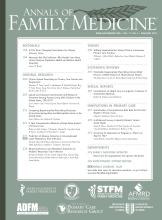Article Figures & Data
Tables
Characteristic PVC Mean (SD) or r P Value Patient age, years 0–6 (n = 258) 4.48 (0.61) <.001 7–12 (n = 146 4.32 (0.81) 13–18 (n = 156) 4.25 (0.85) 19–39 (n = 657) 4.19 (0.80) 40–64 (n = 974) 4.46 (0.70) ≥65 (n = 557) 4.67 (0.56) Patient sex Male (n = 1,049) 4.38 (0.73) .015 Female (n = 1,707) 4.44 (0.73) Patient race White (n = 2,501) 4.42 (0.73) .326 Not white (n = 262) 4.38 (0.77) Educational level attained High school graduate or less (n = 1,014) 4.51 (0.70) <.001 More than high school (n = 1,155) 4.35 (0.73) Number of visits to practice in last year 0.20 <.001 Usual provider continuity index 0.14 <.001 Index physician is patient’s regular doctor No (n = 232) 4.00 (0.86) <.001 Yes (n = 2,459) 4.46 (0.70) Years as a patient of the index physician 0.22 <.001 Insurance Medicare (n = 594) 4.66 (0.58) <.001 Undeterminable (n = 19) 4.58 (0.49) Unclassified (n = 24) 4.47 (0.65) Medicaid (n = 146) 4.45 (0.71) Other (n = 32) 4.43 (0.67) None (n = 185) 4.37 (0.87) Managed care (n = 1,087) 4.36 (0.73) Fee for service (n = 676) 4.29 (0.76) Number of medications taken 0.19 <.001 Number of chronic illnesses 0.20 <.001 Self-reported health status In general −0.09 <.001 Health problems limit daily activities −0.08 <.001 Bothered by emotional problems −0.01 .576 Amount of bodily pain −0.07 <.001 Difficulty doing everyday work −0.08 <.001 Summary measure −0.09 <.001 Components of Primary Care Instrument Accumulated knowledge 0.40 <.001 Coordination of care 0.45 <.001 Interpersonal communication 0.39 <.001 - Table 2.
Patient’s Assessment of the Adequacy of Their Primary Care Visit as a Function of Valuing Continuity of Care and Seeing Their Regular Physician
Value of Continuity Main Effects Interaction Assessment of Visit Low Medium High Value of Continuity Regular Doctor Value of Continuity with Regular Doctor Note: For the above comparisons, the 6 cell sizes for each comparison ranged from 32–1,167. Expectations met Regular doctor 4.08 4.37 4.63 <.001 <.001 .06 Not regular doctor 3.86 4.19 4.14 Things I wanted to bring up but could not Regular doctor 2.05 1.75 1.42 <.001 .48 .36 Not regular doctor 1.95 1.98 1.55 Doctor addressed my main concern Regular doctor 4.34 4.67 4.87 <.001 .006 .32 Not regular doctor 4.29 4.50 4.65 Satisfaction with physician Regular doctor 4.11 4.36 4.66 <.001 <.001 <.001 Not regular doctor 3.96 4.10 4.04 Physician’s accumulated knowledge of the patient Regular doctor 3.10 3.48 3.93 <.001 <.001 <.001 Not regular doctor 2.31 2.35 2.35 Coordination of care Regular doctor 3.30 3.78 4.32 <.001 <.001 .004 Not regular doctor 2.92 3.01 3.30 Interpersonal communication Regular doctor 3.95 4.31 4.63 <.001 <.001 <.001 Not regular doctor 3.67 3.76 3.79 - Table 3.
Regression Models Examining Patient Characteristics, Visit Characteristics, Seeing Regular Physician, and Patient’s Valuing Continuity as Predictors of Patient Rating of Satisfaction with the Physician Visit
Characteristics Model 1 Model 2* Model 3 † β SE(β) P Value β SE(β) P Value β SE(β) P Value * Model 2 includes visit characteristics (length and number of problems). † Model 3 Includes visit characteristics and interaction of value of continuity and regular physician. ‡ Reference category for categorical variables. § Reference category is male. Patient characteristics Age, years 13–39‡ 0–12 .042 .044 .340 .051 .044 .251 −.001 .045 .984 40 and older .179 .033 < .001 .156 .034 <.001 .080 .034 .019 Sex§ .052 .027 .055 .037 .027 .178 .018 .028 .514 Health status .086 .018 < .001 .103 .018 <.001 .084 .019 < .001 Number of visits in previous year .009 .005 .090 .013 .005 .020 .000 .006 .998 Insurance type Fee for service‡ Managed care −.029 .034 .387 −.032 .034 .341 −.053 .034 .120 Medicare .071 .042 .087 .071 .042 .092 −.006 .044 .901 Medicaid .047 .065 .471 .071 .065 .275 .030 .066 .649 None −.025 .056 .663 −.037 .057 .516 −.096 .059 .103 Other −.038 .078 .623 −.012 .078 .878 −.075 .085 .374 Visit characteristics Length of visit .013 .002 < .001 .013 .003 <.001 Number of problems addressed .024 .013 .062 .010 .013 .443 Continuity Visit made to regular physician −.555 .231 .017 Patient value of continuity .105 .052 .044 Interaction of patient value of continuity with regular physician .207 .056 <.001 Model R2 .025 .042 .148







